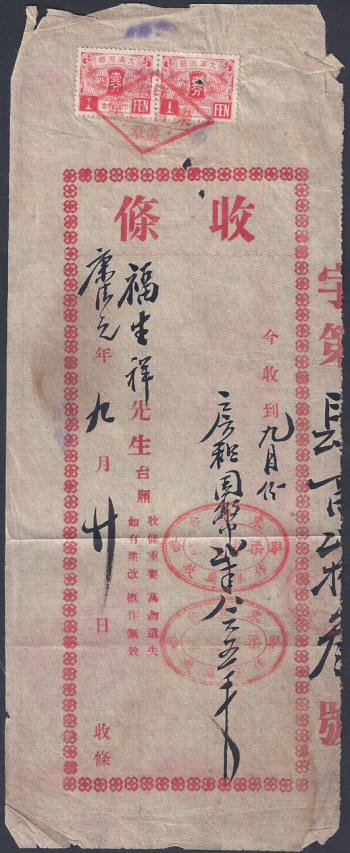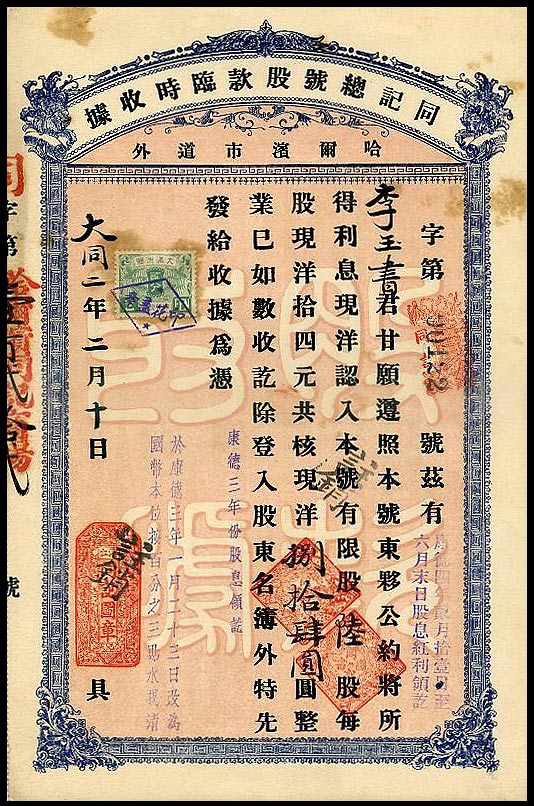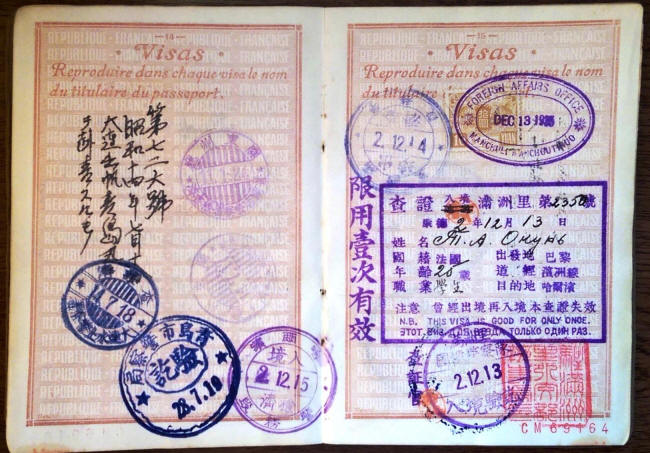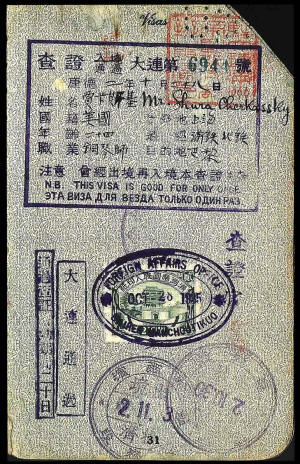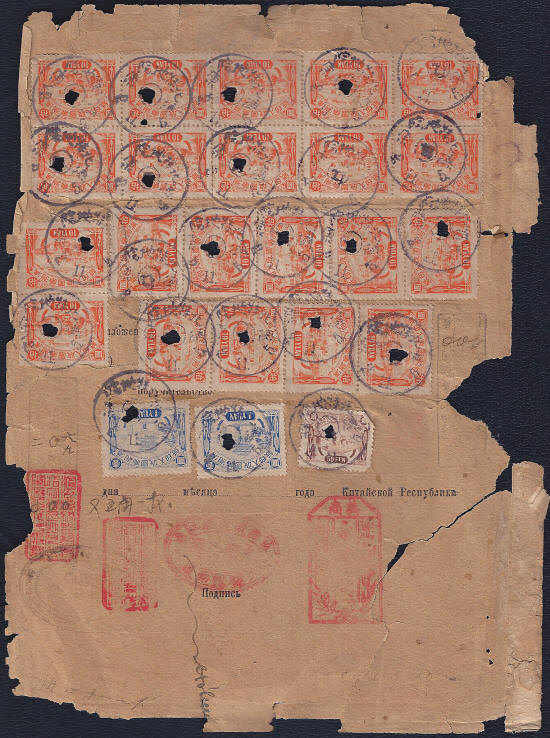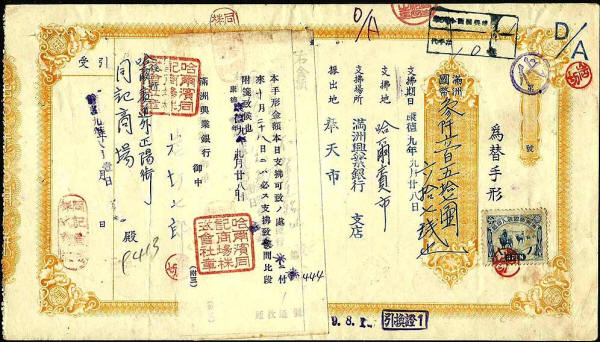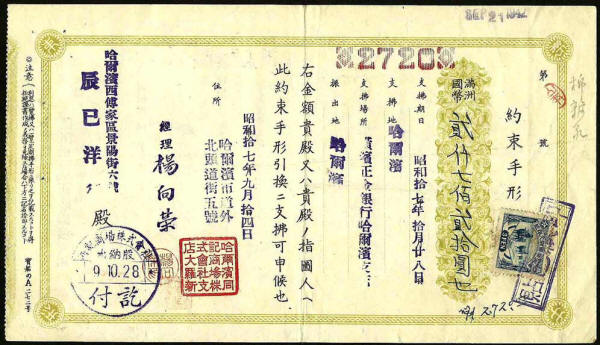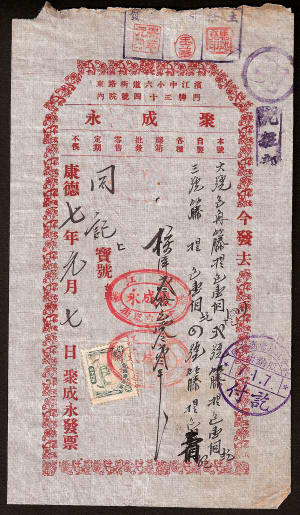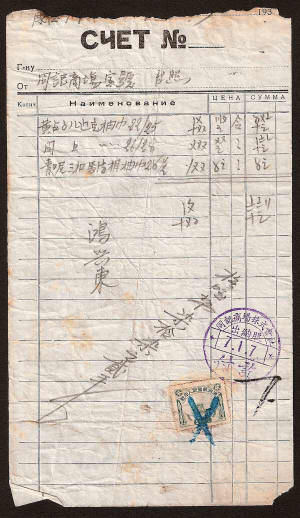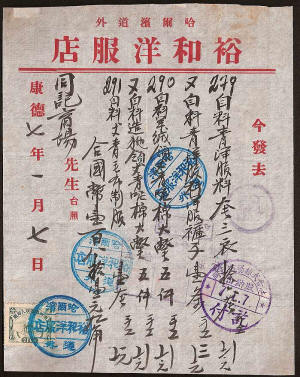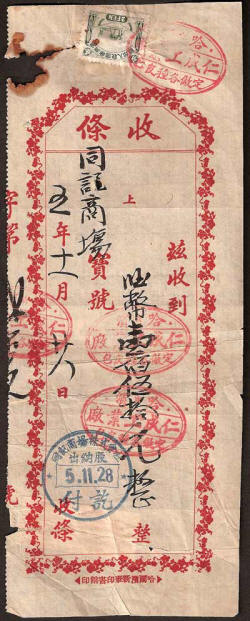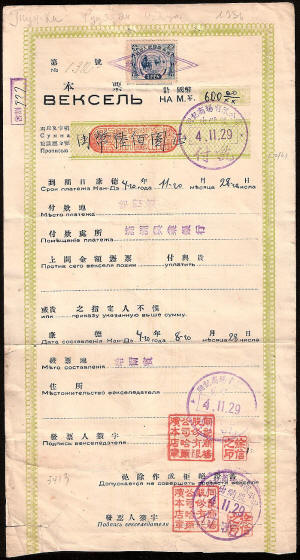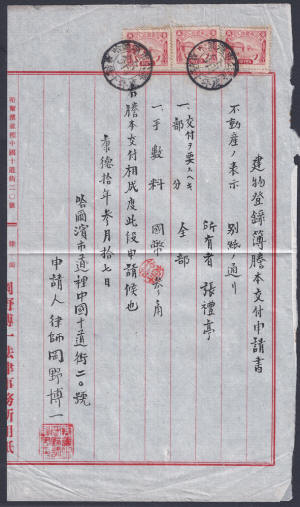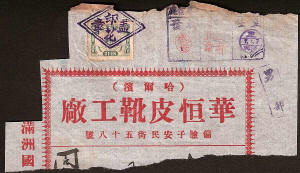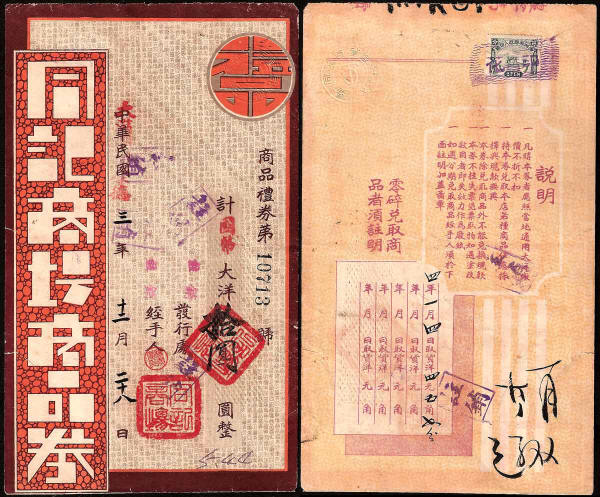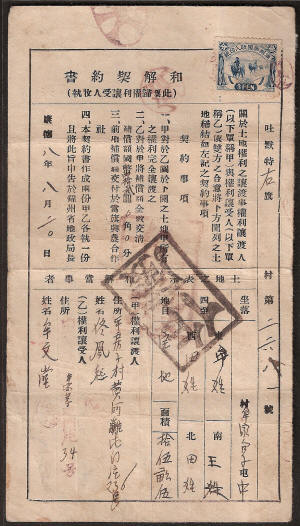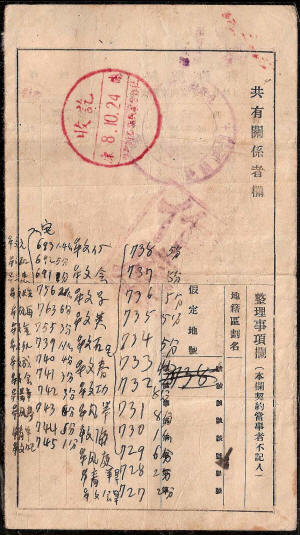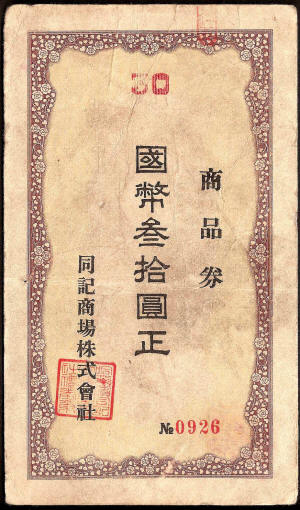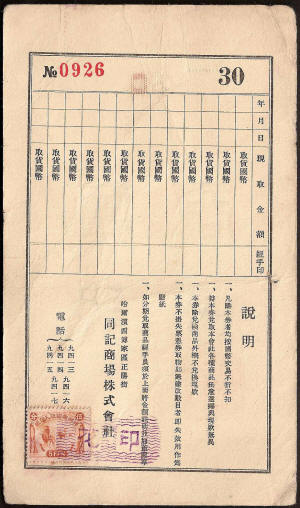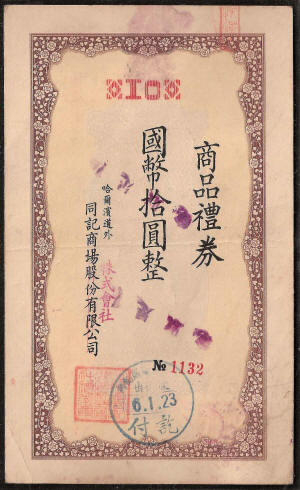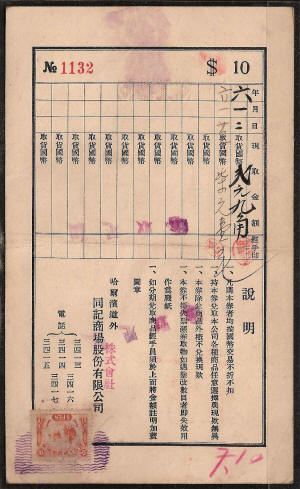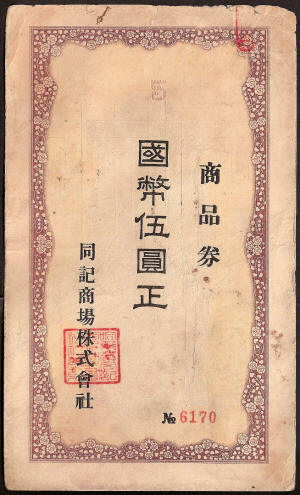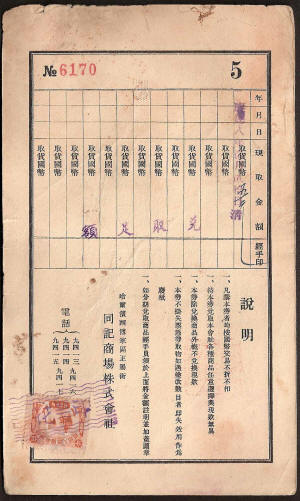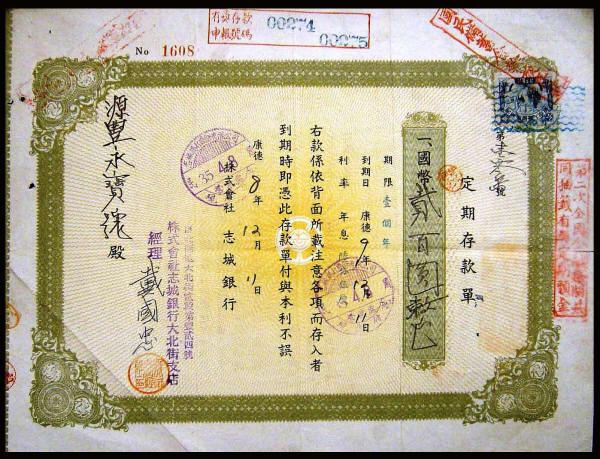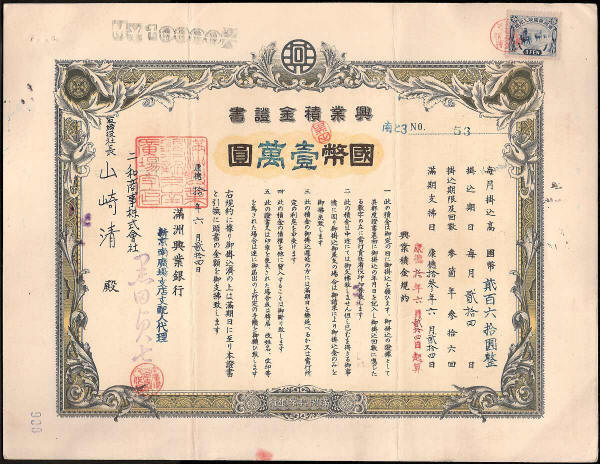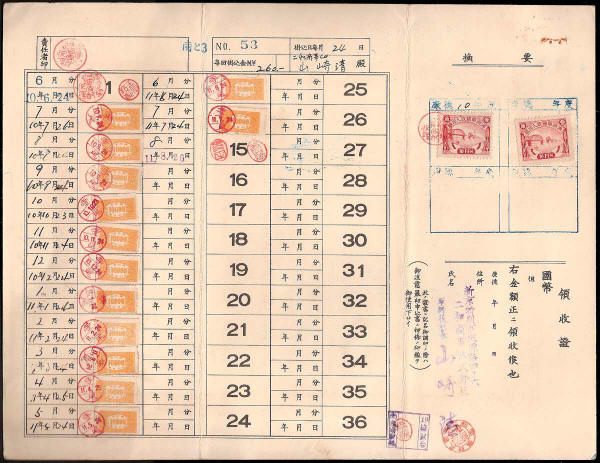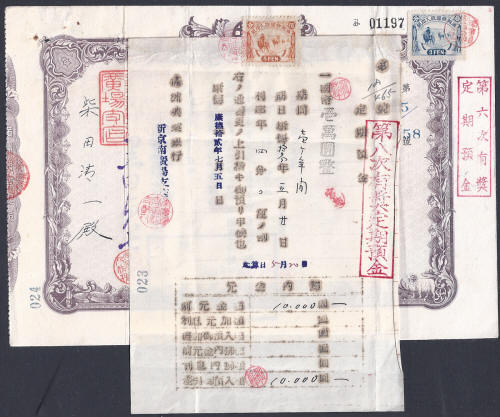 |
|||||||
|
|
Manchukuo First Regular Issue Revenue Stamps on Paper First revenue stamps on paper are hard to find. Most are examples of purchase tax or court use. Shop receipt with two 1f "First" revenue stamps.
Tongji Department Store Receipt (Harbin) with a 2f First Revenue Stamp. To see the reverse click here
Manchukuo Second Regular Issue Revenue Stamps on Paper This is a small selection of Manchukuo Revenue stamps still on the original documents. Some items are from the White Russian community and some Chinese. Any help with interpretation would be appreciated. This is a 1935 French Passport stamped at Manchuli allowing entry from Russia to Manchukuo, probably via the Trans Siberian railway. Note that the revenue stamp used is the 1st issue 10 Yuan and the oval hand-stamps indicate Consular use. 1935 Passport for the famous Russian Pianist Shura Cherkassky who was on a world tour which lasted from 1935 until 1938. The passport has a Second Issue 2 Yuan revenue stamp. |
||||||
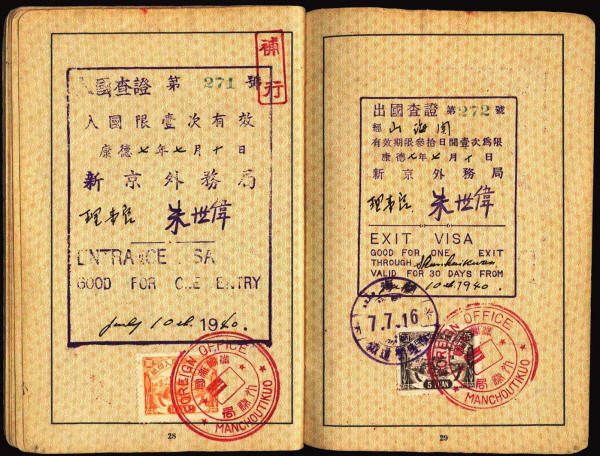 |
|||||||
| July 1940 - Examples of 10 Yuan and 5 Yuan revenues in use on a German passport. | |||||||
| (Both of the above three passport images are courtesy of Neil Kaplan) | |||||||
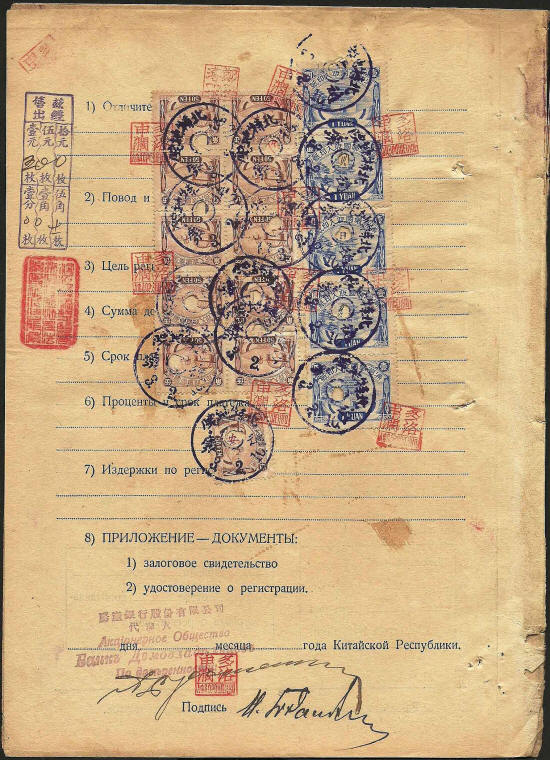 |
|||||||
|
This is a contract to rent and apartment
contract, possibly issued by a Russian Real Estate firm in Harbin.
The signatures, chops and firm stamp are in a mixture of Russian and
Chinese. The revenue stamps used are 5 x 1y and 11 x 50f, making the
total tax paid on this transaction 10.5 Yuan. (Picture courtesy of Neil Kaplan)
This is another Russian real estate document with stamps to the much higher value of Y212.50, again the stamps have been holed to prevent re-use. |
|||||||
|
Manchurian Cheque with a 3f Revenue Stamp (to see the reverse click here). A promissory note from the Yokohama Specie Bank (presumably the bank is the lender). This is a short term loan, taken out Showa 17.9.14 and repayable Showa 17.10.28. with a 3f Revenue Stamp. The Tongji department store circular date stamp in blue, shows that it was repaid on time - Kangde 9.10.28 (to see the reverse click here).
|
|||||||
|
This appears to be an invoice or receipt issued by a primary school (中小). The is hand written inscription to the right of the date is for Tongji (同记宝号), the department store chain. Dated 7th January 1940, the transaction attracted a purchase tax payment of 2f as shown by the shop cancelled revenue stamp. |
訖仃 | ||||||
|
This is probably a receipt or invoice for the clothing from the Yu He Yang (裕和洋) Clothing Store in Harbin. Characters read 'white material' (Bai liao 白料) and 'clothing material' (Fu liao 服料). Dated 7th January 1940, the transaction attracted a purchase tax payment of 2f as shown by the shop cancelled revenue stamp. |
|||||||
|
Court Document with 3 x 10f 2nd Issue Revenue Stamps |
|||||||
|
Part of a receipt from the Hua Heng Boot Factory(Hua Heng Pixue Gongchang 华恒皮靴工) in Harbin 哈尔滨). Date unknown the transaction attracted a purchase tax payment of 2f as shown by the shop cancelled revenue stamp. |
|||||||
|
1936 Tongji Department Stores voucher with a 2f revenue stamp. This is interesting because it is a pre-occupation Minguo issue. The 中華民國 Chinese Republic year date is overprinted with rubber-stamp to read 大滿洲帝國康德 Manchurian Empire Kangde and the currency is in old silver changed in red-overprint to GUO BI, national currency, in this case Manchurian Yuan. |
|||||||
|
3f revenue stamp in use on a document dated 8th September 1941 - Front and back shown. |
|||||||
|
5f revenue stamps in use attached to an unused 30 Yuan Voucher, 10 Yuan Voucher and 5 Yuan Voucher dated 23rd January 1939 and 22nd April 1942, the size of these items is 116mm x 198mm and they are printed on thick paper with a watermark of four large characters. The vouchers were issued at branches the Tongji Department Stores, one of the largest retailers in Manchuria. 20Y and 50Y vouchers are also available. The revenue stamps are added when the voucher is issued and not when cashed, and there seems to be the same 5f stamp required for both values. Other values may be obtainable. The vouchers appear to have been issued in Harbin and Kirin and the numbering seems to be consistent with the dates of issue, ie; the lower the number, the earlier the date. Above is a fixed-savings-deposit, from the ZHI CHENG YINHANG, meaning the Bank of Zhicheng, dating from 1941. It is interesting to see that it was still valid after the war ended and the investor paid in 1946. Note the 3f revenue stamp. Above is an investment certificate with a face value of 10,000 Manchukuo Yuan issued by the Manchurian Industrial Bank. To realise the investment the customer was required to make a deposit of 260y each month for 36 months. Having made the monthly payments, a total of 9,360y, a sum of 640y would be added by the bank and the customer would have received a total of 10,000y. With the term completed the investment would have earned 4.5% over 3 years (or 1.5% p.a). It should be noted that the customer, probably a company, only completed 15 payments. My thanks to Neil Kaplan for this explanation. The Certificate shows a 3f revenue stamp on the face side, paid at issue, and seems to have attracted a 10f per annum charge while in use denoted by the 10f revenue stamps on the reverse side.
This is a fixed deposit certificate
for Y10,000 with an early release of funds
issued by
滿洲興業銀行
the Manchurian Industrial Bank. The
conditions where changed so instead of issuing a new one they
altered them by applying the slip. The tax on the initial
transaction was 3f and 5f seems to have been charged for the altered
terms. To see under the slip click
here. My thanks to Neil Kaplan for this explanation.
|
|||||||

